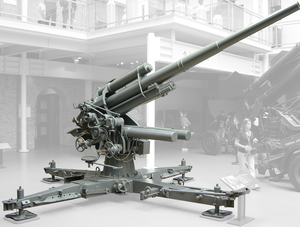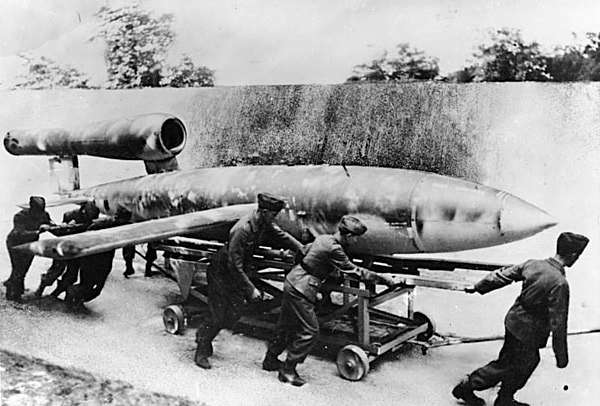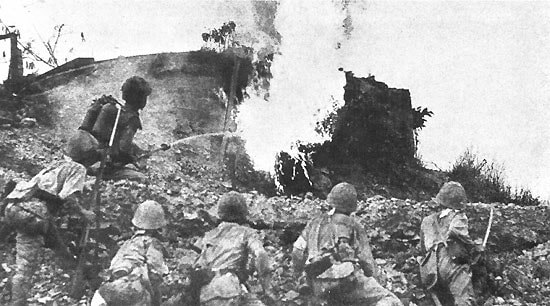|
by Vadym Velychko World War II, a global conflict that reshaped the world, was not only a testament to human resilience and the quest for freedom but also a crucible for technological and strategic military innovations. Amidst the backdrop of this devastating conflict, the ingenuity of nations was put to the test, leading to the development of weapons that would forever alter the landscape of warfare. This narrative delves into the intricacies of three such innovations: the German Flak 88mm anti-aircraft gun, the V1 Rocket, the first of its kind cruise missile, and the Type 93 flamethrower, a symbol of the ferocity of close-quarters combat. Each of these weapons symbolizes a leap forward in military technology, reflecting the intense pressure of wartime demands and the human capacity for innovation in the face of adversity. Their stories are not just tales of technological triumph but also stark reminders of the war's profound human toll. This introduction sets the stage for a deeper understanding of how these weapons came to be, their influence on the course of World War II, and their lasting legacy on the art and ethics of warfare. The German Flak 88mm: Originally designed as an anti-aircraft cannon, the Flak 88mm quickly gained a reputation for its versatility on the battlefield. Allied forces feared it for its ability to destroy tanks, aircraft, and infantry with equal effectiveness. Its high muzzle velocity and accuracy made it a formidable defensive weapon against Allied armored assaults.[1] During the D-Day landings and subsequent Battle of Normandy, the Flak 88 was used to defend against the Allied invasion. It was also employed in an anti-tank role, where it was one of the few German weapons capable of dealing effectively with Allied tanks such as the Sherman and the Churchill.[2] V1 Rocket: Known as the "Vergeltungswaffe 1," this early cruise missile was a terror weapon used by Germany, primarily against London and other targets in England. The psychological impact of the V1's distinctive buzzing sound, followed by silence before impact, caused widespread fear. Despite its inaccuracy, the sheer number of these weapons launched inflicted significant casualties and damage. The use of the V1 began on June 13, 1944, shortly after the D-Day landings (June 6, 1944), marking a new phase in the war against Britain, which Germany called "Operation Eisbär" (Polar Bear). The launch sites were located in occupied France and the Low Countries, allowing the Germans to target England's southeast and London, which was the primary target due to its political and economic significance. The V1 attacks continued until March 1945, when the last V1 was launched against Britain. Over this period, thousands of V1s were fired. The attacks caused significant casualties and damage but ultimately did not achieve the strategic impact the Germans had hoped for. The British developed countermeasures, including anti-aircraft guns, barrage balloons, and night fighters equipped with radar, to intercept and destroy the V1s before they could reach their targets. In addition to its use against Allied cities, the V1 was also used on the Western Front to target advancing Allied forces following the D-Day invasion, although its effectiveness in this role was limited compared to its psychological and material impact on civilian targets. Type 93 flamethrower: Although the U.S. Marines famously used flamethrowers in WW2, the Imperial Japanese Army also used flamethrowers during the war. Flamethrowers were part of the diverse arsenal employed by Japanese forces in various theaters of the war, especially in the Pacific. The Type 93 was characterized by its portability and effectiveness in dense jungle warfare, where traditional firearms were sometimes less effective due to visibility and range limitations. It consisted of a fuel tank, a propellant tank (usually compressed air or nitrogen), and a wand with a nozzle to direct the flame. The fuel was typically a flammable liquid, such as a mixture of gasoline and oil, which was ignited as it was expelled, creating a stream of fire. [4] One notable instance of flamethrower was during the Battle of Bataan, which was marked by brutal combat conditions, with both sides facing extreme challenges. The Type 93 flamethrower, used by the Imperial Japanese Army, was a portable flamethrower designed for infantry use. It would have been used to clear enemy fortifications, bunkers, and dense jungle positions, providing a psychological and tactical advantage in close-quarters combat. The use of such weapons would align with Japanese military tactics of employing a range of equipment and strategies to overcome enemy defenses. The use of flamethrowers by the Japanese would have been part of their effort to break the strong defensive positions held by the combined Filipino and American forces. The battle ended in a Japanese victory, but at a high cost to both the defenders and the attackers, leading to the subsequent Bataan Death March, one of the war's most harrowing events for POWs. Another significant example was in the battles of Peleliu and Okinawa, where Japanese troops used flamethrowers in a similar manner. These battles involved fierce close-quarters combat, with flamethrowers being used to try to flush out or incinerate enemy soldiers from their positions. The use of flamethrowers reflects the intense and desperate nature of the Pacific War, where both sides sought to overcome the challenges of fighting in difficult terrain and against deeply entrenched opponents. [5] The Second World War was not only a clash of nations but also a battleground of technological ingenuity and strategic innovation. The weapons detailed here—the German Flak 88mm, the V1 Rocket, and the Type 93 flamethrower—serve as a testament to the relentless pursuit of military advantage through technological advancement. Each weapon, with its unique capabilities and strategic deployment, played a pivotal role in shaping the course of battles and, by extension, the war itself. From the Flak 88's unmatched versatility on the battlefield to the psychological terror induced by the V1 rockets and the intense close-quarters combat facilitated by the Type 93 flamethrower, these weapons exemplified the era's cutting-edge military technology. Their impact went beyond the immediate tactical advantages they provided, influencing the development of post-war defense strategies and changing the nature of modern warfare. The use of these weapons highlighted the importance of innovation, adaptability, and strategic foresight in military conflict. It also underscored the grim reality of war, where technological advancements often come with a high human cost, as seen in the devastating effects of these weapons on both soldiers and civilians alike. As we reflect on the technological advancements and strategic innovations of World War II, it is crucial to remember the lessons learned and the human costs incurred. The legacy of these weapons serves as a reminder of the importance of striving for peace and the need to manage technological progress with caution and responsibility. In doing so, we honor the memory of those who lived through the horrors of war and reaffirm our commitment to preventing such conflicts in the future. Sources:1. "Terrifying Weapons of WWII." War History Online, n.d., https://www.warhistoryonline.com/instant-articles/terrifying-weapons-of-wwii.html.
2. "88-mm Flak 16." D-Day Overlord, https://www.dday-overlord.com/en/material/artillery/88-mm-flak-16#:~:text=During%20the%20Battle%20of%20Normandy,the%20same%20despite%20the%20distance. 3. "The Terrifying German Revenge Weapons of the Second World War." Imperial War Museums, https://www.iwm.org.uk/history/the-terrifying-german-revenge-weapons-of-the-second-world-war. 4. "Handbook on Japanese Military Forces." HyperWar: A Hypertext History of the Second World War, Ibiblio, http://www.ibiblio.org/hyperwar/Japan/IJA/HB/HB-9.html#III. 5. Rottman, Gordon L. The Japanese Army in World War II. Osprey Publishing, 2005.
2 Comments
2/21/2024 12:16:05 am
Nice for information
Reply
Jamal Johnson
5/3/2024 07:56:34 am
If the toilet was shot than the bombs is yes? True or false?
Reply
Leave a Reply. |
- Home
- Stories
-
Internship
- Summer 2024 Internship
- Summer 2023 Internship
- Fall 2022 Internship
- Summer 2022 Internship
- Summer 2021 Internship
- Fall 2020- Spring 2021 Internship
- Summer 2020 Internship
- Fall 2019 Internship
- Summer 2019 Internship >
- School Year 2018-2019 Internship
- Summer 2018 Internship >
- Fall 2017 Internship
- Summer 2017 Internship >
- Books
- Archives
-
Resource Page
-
Supplementary Research Guides
>
- Unit 731 - Guide >
-
Philippines' Resistance - Guide
>
- Philippines World War II Timeline
- The Japanese Invasion & Conquest of the Philippines
- Bataan Death March
- Formation of Underground Philippines Resistance
- Supplies of the Guerrilla Fighters
- The Hukbalahap
- Hunter's ROTC
- Marking's Guerrillas
- United States Army Forces in the Philippines of Northern Luzon (USAFIP-NL)
- The Aetas
- Chinese and Filipino-Chinese Nationalist Guerrilla Units
- The Female Faces of the Philippine Guerrillas
- Rising Sun Flag - Guide >
- Pinay Guerrilleras - Guide >
- Fall of Singapore - Guide >
- Three Years and Eight Months - Guide >
- Siamese Sovereignty - Guide >
- The Khabarovsk War Crimes Trial - Guide >
- Unit 731 Cover-up : The Operation Paperclip of the East - Guide >
- Marutas of Unit 731 - Guide >
- Prince Konoe Memoir - Guide >
- Competing Empires in Burma - Guide >
- Battle of Shanghai - Guide >
- Ishi Shiro - Guide >
- Taiwan The Israel of the East - Guide >
- Seeking Justice for Biological Warfare Victims of Unit 731 - Guide >
- Rice and Revolution - Guide >
- Clash of Empires - Guide >
-
Hunger for Power and Self-SufficiencyI - Guide
>
- The Influence of War Rations on Post-War Culinary Transformations
- How World War II Complicated Food Scarcity and Invention
- American Military Innovations
- Government-Sponsored Food Inventions in Europe during World War II
- Feeding the Army: The Adaptation of Japanese Military Cuisine and Its Impact on the Philippines
- Mixed Dishes: Culinary Innovations Driven by Necessity and Food Scarcity
-
Denial A Quick Look of History of Comfort Women and Present Days’ Complication - Guide
>
- The Comfort Women System and the Fight for Recognition
- The Role of Activism and International Pressure
- The Controversy over Japanese History Textbooks
- The Sonyŏsang Statue and the Symbolism of Public Memorials
- Activism and Support from Japanese Citizens
- The Future of Comfort Women Memorials and Education
- Echoes of Empire: The Power of Japanese Propaganda - Guide >
- Lesson Plans >
-
Supplementary Research Guides
>
|
Pacific Atrocities Education
730 Commercial Street San Francisco, CA 94108 415-988-9889 |
Copyright © 2021 Pacific Atrocities Education.
We are a registered 501 (c)(3) charity. |
- Home
- Stories
-
Internship
- Summer 2024 Internship
- Summer 2023 Internship
- Fall 2022 Internship
- Summer 2022 Internship
- Summer 2021 Internship
- Fall 2020- Spring 2021 Internship
- Summer 2020 Internship
- Fall 2019 Internship
- Summer 2019 Internship >
- School Year 2018-2019 Internship
- Summer 2018 Internship >
- Fall 2017 Internship
- Summer 2017 Internship >
- Books
- Archives
-
Resource Page
-
Supplementary Research Guides
>
- Unit 731 - Guide >
-
Philippines' Resistance - Guide
>
- Philippines World War II Timeline
- The Japanese Invasion & Conquest of the Philippines
- Bataan Death March
- Formation of Underground Philippines Resistance
- Supplies of the Guerrilla Fighters
- The Hukbalahap
- Hunter's ROTC
- Marking's Guerrillas
- United States Army Forces in the Philippines of Northern Luzon (USAFIP-NL)
- The Aetas
- Chinese and Filipino-Chinese Nationalist Guerrilla Units
- The Female Faces of the Philippine Guerrillas
- Rising Sun Flag - Guide >
- Pinay Guerrilleras - Guide >
- Fall of Singapore - Guide >
- Three Years and Eight Months - Guide >
- Siamese Sovereignty - Guide >
- The Khabarovsk War Crimes Trial - Guide >
- Unit 731 Cover-up : The Operation Paperclip of the East - Guide >
- Marutas of Unit 731 - Guide >
- Prince Konoe Memoir - Guide >
- Competing Empires in Burma - Guide >
- Battle of Shanghai - Guide >
- Ishi Shiro - Guide >
- Taiwan The Israel of the East - Guide >
- Seeking Justice for Biological Warfare Victims of Unit 731 - Guide >
- Rice and Revolution - Guide >
- Clash of Empires - Guide >
-
Hunger for Power and Self-SufficiencyI - Guide
>
- The Influence of War Rations on Post-War Culinary Transformations
- How World War II Complicated Food Scarcity and Invention
- American Military Innovations
- Government-Sponsored Food Inventions in Europe during World War II
- Feeding the Army: The Adaptation of Japanese Military Cuisine and Its Impact on the Philippines
- Mixed Dishes: Culinary Innovations Driven by Necessity and Food Scarcity
-
Denial A Quick Look of History of Comfort Women and Present Days’ Complication - Guide
>
- The Comfort Women System and the Fight for Recognition
- The Role of Activism and International Pressure
- The Controversy over Japanese History Textbooks
- The Sonyŏsang Statue and the Symbolism of Public Memorials
- Activism and Support from Japanese Citizens
- The Future of Comfort Women Memorials and Education
- Echoes of Empire: The Power of Japanese Propaganda - Guide >
- Lesson Plans >
-
Supplementary Research Guides
>



